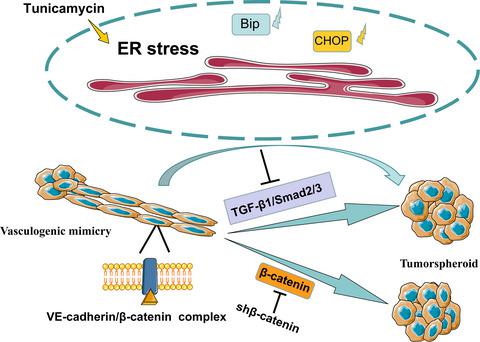当前位置:
X-MOL 学术
›
FEBS Open Bio
›
论文详情
Our official English website, www.x-mol.net, welcomes your feedback! (Note: you will need to create a separate account there.)
Endoplasmic reticulum stress inhibits 3D Matrigel-induced vasculogenic mimicry of breast cancer cells via TGF-β1/Smad2/3 and β-catenin signaling
FEBS Open Bio ( IF 2.6 ) Pub Date : 2021-07-28 , DOI: 10.1002/2211-5463.13259 Huifen Liu 1 , Hao Wang 2 , Dan Chen 1 , Cuirong Gu 1 , Jianming Huang 1 , Kun Mi 1
FEBS Open Bio ( IF 2.6 ) Pub Date : 2021-07-28 , DOI: 10.1002/2211-5463.13259 Huifen Liu 1 , Hao Wang 2 , Dan Chen 1 , Cuirong Gu 1 , Jianming Huang 1 , Kun Mi 1
Affiliation

|
Endoplasmic reticulum (ER) stress is a cellular stress condition involving disturbance in the folding capacity of the ER caused by endogenous and exogenous factors. ER stress signaling pathways affect tumor malignant growth, angiogenesis and progression, and promote the antitumor effects of certain drugs. However, the impact of ER stress on the vasculogenic mimicry (VM) phenotype of cancer cells has not been well addressed. VM is a phenotype that mimics vasculogenesis by forming patterned tubular networks, which are related to stemness and aggressive behaviors of cancer cells. In this study, we used tunicamycin (TM), the unfolded protein response (UPR)-activating agent, to induce ER stress in aggressive triple-negative MDA-MB-231 breast cancer cells, which exhibit a VM phenotype in 3D Matrigel cultures. TM-induced ER stress was able to inhibit the VM phenotype. In addition to the tumor spheroid phenotype observed upon inhibiting the VM phenotype, we observed alterations in glycosylation of integrin β1, loss of VE-cadherin and a decrease in stem cell marker Bmi-1. Further study revealed decreased activated transforming growth factor β1, Smad2/3, Phospho-Smad2 and β-catenin. β-Catenin knockdown markedly inhibited the VM phenotype and resulted in the loss of VE-cadherin. The data suggest that the activation of ER stress inhibited VM phenotype formation of breast cancer cells via both the transforming growth factor β1/Smad2/3 and β-catenin signaling pathways. The discovery of prospective regulatory mechanisms involved in ER stress and VM in breast cancer could lead to more precisely targeted therapies that inhibit vessel formation and affect tumor progression.
中文翻译:

内质网应激通过 TGF-β1/Smad2/3 和 β-catenin 信号传导抑制 3D Matrigel 诱导的乳腺癌细胞血管生成拟态
内质网(ER)应激是一种细胞应激状态,涉及内源性和外源性因素引起的 ER 折叠能力紊乱。ER应激信号通路影响肿瘤的恶性生长、血管生成和进展,并促进某些药物的抗肿瘤作用。然而,内质网应激对癌细胞血管生成拟态(VM)表型的影响尚未得到很好的解决。VM是一种通过形成模式化管状网络来模拟血管发生的表型,这与癌细胞的干性和侵袭行为有关。在这项研究中,我们使用衣霉素 (TM)(一种未折叠蛋白反应 (UPR) 激活剂)在侵袭性三阴性 MDA-MB-231 乳腺癌细胞中诱导 ER 应激,该细胞在 3D 基质胶培养物中表现出 VM 表型。TM诱导的ER应激能够抑制VM表型。除了抑制 VM 表型后观察到的肿瘤球体表型外,我们还观察到整合素 β1 糖基化的改变、VE-钙粘蛋白的丢失和干细胞标记物 Bmi-1 的减少。进一步研究显示活化的转化生长因子 β1、Smad2/3、Phospho-Smad2 和 β-catenin 减少。β-Catenin 敲除显着抑制 VM 表型并导致 VE-cadherin 丢失。数据表明,ER应激的激活通过转化生长因子β1/Smad2/3和β-连环蛋白信号通路抑制乳腺癌细胞VM表型的形成。乳腺癌中与 ER 应激和 VM 相关的前瞻性调节机制的发现可能会导致更精确的靶向治疗,从而抑制血管形成并影响肿瘤进展。
更新日期:2021-09-01
中文翻译:

内质网应激通过 TGF-β1/Smad2/3 和 β-catenin 信号传导抑制 3D Matrigel 诱导的乳腺癌细胞血管生成拟态
内质网(ER)应激是一种细胞应激状态,涉及内源性和外源性因素引起的 ER 折叠能力紊乱。ER应激信号通路影响肿瘤的恶性生长、血管生成和进展,并促进某些药物的抗肿瘤作用。然而,内质网应激对癌细胞血管生成拟态(VM)表型的影响尚未得到很好的解决。VM是一种通过形成模式化管状网络来模拟血管发生的表型,这与癌细胞的干性和侵袭行为有关。在这项研究中,我们使用衣霉素 (TM)(一种未折叠蛋白反应 (UPR) 激活剂)在侵袭性三阴性 MDA-MB-231 乳腺癌细胞中诱导 ER 应激,该细胞在 3D 基质胶培养物中表现出 VM 表型。TM诱导的ER应激能够抑制VM表型。除了抑制 VM 表型后观察到的肿瘤球体表型外,我们还观察到整合素 β1 糖基化的改变、VE-钙粘蛋白的丢失和干细胞标记物 Bmi-1 的减少。进一步研究显示活化的转化生长因子 β1、Smad2/3、Phospho-Smad2 和 β-catenin 减少。β-Catenin 敲除显着抑制 VM 表型并导致 VE-cadherin 丢失。数据表明,ER应激的激活通过转化生长因子β1/Smad2/3和β-连环蛋白信号通路抑制乳腺癌细胞VM表型的形成。乳腺癌中与 ER 应激和 VM 相关的前瞻性调节机制的发现可能会导致更精确的靶向治疗,从而抑制血管形成并影响肿瘤进展。


























 京公网安备 11010802027423号
京公网安备 11010802027423号